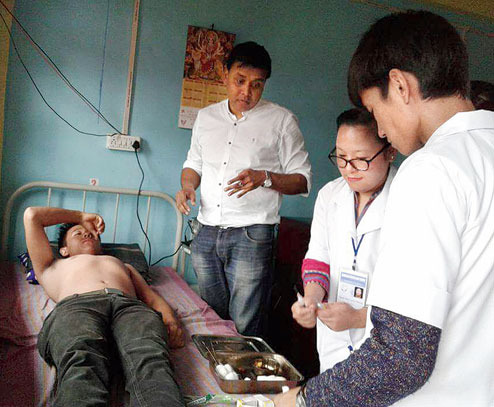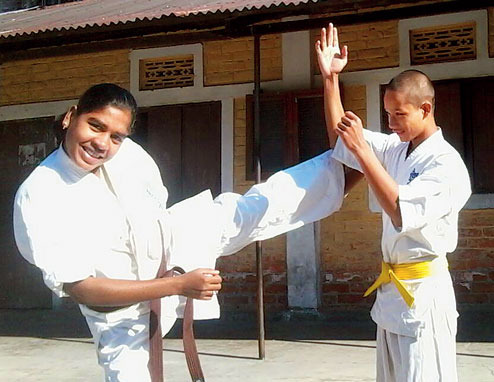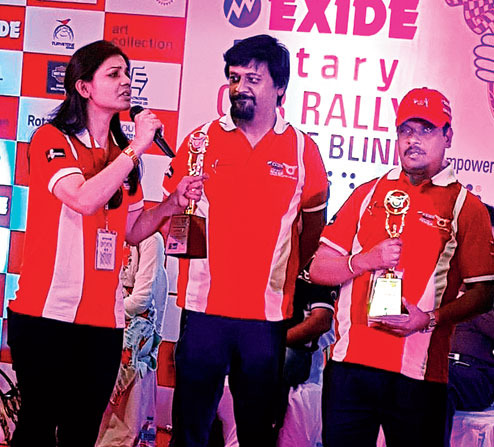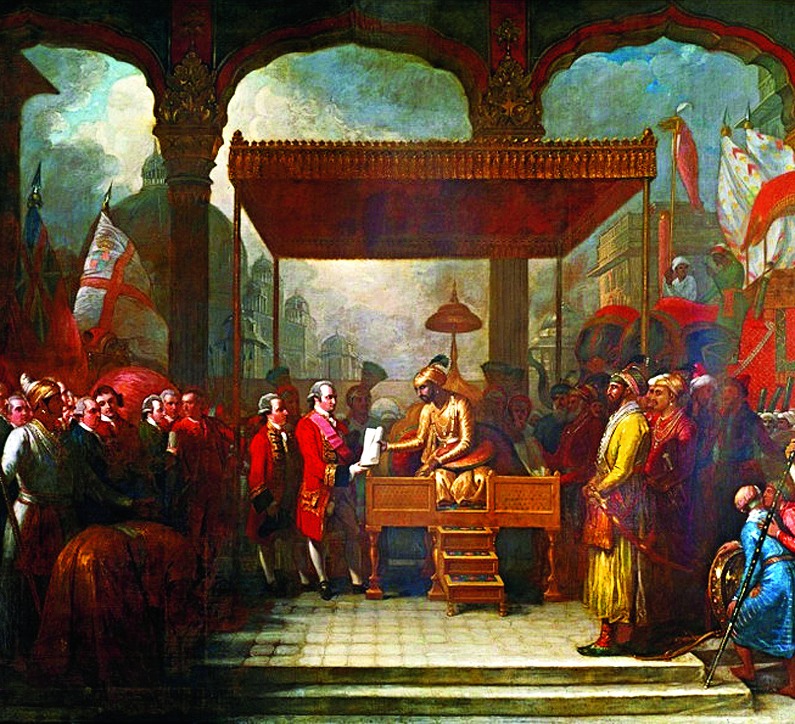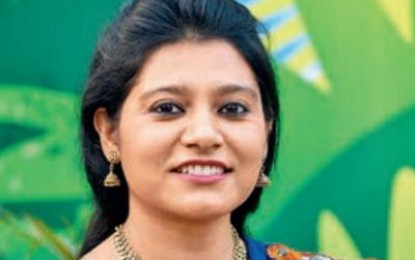A yearning for Calcutta handed down three generations like a family heirloom has culminated in a fascinating journey by one of them back to where it all began.
The story starts with Myrtle Natal Borland, who in 1918 gave up a promising career in music in her hometown Durban to accompany her husband to India and become the first woman to sing on radio in Calcutta. Then came Marjorie, born to Myrtle at Calcutta’s Eden Hospital in 1922.
Mother and daughter returned to their native country in 1942, but continued to live with their India memories. Neither was able to make another trip, a regret that Marjorie’s daughter Olivia erased last Sunday when she landed in Calcutta for what she described to Metro as “a pilgrimage of sorts”.
Recently retired from a long career in teaching and journalism at Pietermaritzburg in KwaZulu-Natal, Olivia Schaffer had always wanted to retrace the steps of her grandmother Myrtle and mother Marjorie to Calcutta.
Myrtle had come to Calcutta by boat in 1918, when a lot of this expanding city did not exist. This Sunday, as Olivia embarked on her journey to the past from her hotel in New Town, rows of towering apartment buildings, zippy flyovers, a new Metro link under construction and the sight of “so many trees” appeared to impress her very much. But Olivia was soon enquiring about how long it would take to reach the “old city”.
Her blue eyes sparkling like a child’s, she said: “I am so excited about seeing the house where my mother and grandmother lived, and where my grandfather started Calcutta’s first radio station.”
John Rouse Stapleton was among those who had been present at the inception of Calcutta’s first radio transmitter and studio in a house rarely remembered for it. That was long before Akashvani Bhavan and Garstin Place became landmarks.
Stapleton had met Myrtle, then 18, aboard a ship to England in 1917. She was headed for London on invitation to sing in the opera houses there. “She had spent months performing across South Africa to raise funds for the trip. Yet she gave it all up when she fell in love with the ship’s British wireless operator,” said Olivia.
Talk turned to her present home in Durban and the Pride of India ( jarul) tree under which her mother’s ashes were scattered. In 2014, then suffering from her final bout of illness, Marjorie Getaz (nee Stapleton) was dictating her memoirs to daughters Olivia, Marianne and Suzanne. More than 70 years after leaving India, Marjorie had not got over her yearning for the city of her birth.
Olivia wrote to AIR on behalf of her mother, seeking to know what the Akashvani motto ” Bahujana Sukhaya Bahujana Hitaya” meant. Nudged by the then Prasar Bharati CEO Jawhar Sircar, AIR Calcutta supplied a translation of the motto “For the happiness of many, for the welfare of many”.
Being able to correctly remember what the motto meant thrilled Marjorie, according to Olivia. She recalled her mother saying: “I have no grumbles because I have enjoyed a very rich, varied and fulfilling life; I still appreciate the aromatic flavours in a good Indian curry.”
When Myrtle and her husband had arrived in Calcutta in 1918, the Marconi Company was starting test broadcasts from various locations after shifting base from Hastings Street to No. 5 Temple Chambers, beside Calcutta High Court. The first concert was heard at a distance of three miles, followed by a discourse 72 miles away. Stapleton and J. Briggs launched the Calcutta Radio Club in 1923 and soon another broadcasting transmitter called 5AF was installed at Temple Chambers. In 1926, a transmission studio for radio broadcasting started on the top floor of Temple Chambers. Stapleton became the station director and his wife the first woman to sing there.
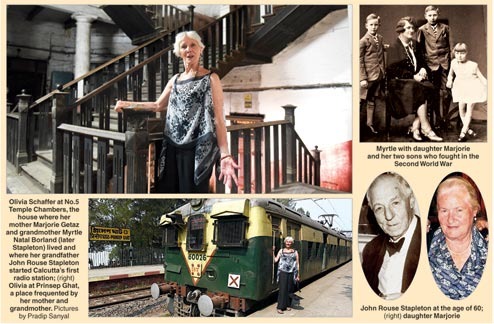
The private Indian Broadcasting Company Ltd took over in 1927 and Stapleton was still the director at its new and more spacious Garstin Place address when the Indian State Broadcasting Service became All India Radio in 1936. For his efforts, Stapleton was awarded the Order of the British Empire.
Marjorie’s memoirs include vivid descriptions of her childhood at 5 Temple Chambers. “We lived upstairs and Dad had his Marconi office downstairs. My first memory was at about the age of three years, when my father’s canary got out of its cage; all the servants were trying to catch it and it landed on my head. I can’t remember whether I was afraid or not but I do remember that my father loved that bird. It used to sing from morning to night. When it died, Dad took a brick out of the sitting-room wall and into that space he placed a coffin in which he had laid the bird.”
So, somewhere in the walls of 5 Temple Chambers, where Calcutta’s first radio came alive, are the remains of a singing bird. The idea comforted Marjorie.
A ride through Park Street past Flurys on Sunday took Olivia to Temple Chambers, which is now a lawyer’s den. It was built in 1910 on the corner of Esplanade Row West and Old Post Office Street, according to a design by Vincent J. Esch, assistant designer of the Victoria Memorial. A worn nameplate, trees growing out of crack, dark damp stains, thick electric cables snaking across the walls and dusty window slats made for a sorry sight. The interiors were dark and there were few people around. As Olivia scanned each floor lined by offices, her mother’s memories seemed unreal.
Past the seemingly immovable antique lift with grills, she climbed the wooden staircase, undaunted. “Unbelievable that these are the stairs my mother and grandmother used! Even the marble tiled floor is the same,” she said.
An open door on the second floor gave her a peek into what would have been her family home.
Marjorie’s narrative about India remains that of a teenager self-occupied and sensitive by turn. She and her mother Myrtle would often go shopping. Was it to the posh departmental store Whiteway Laidlaw & Co (Metropolitan Building), the Army & Navy Stores or the Sir Stuart Hogg Market (now New Market)? Olivia wouldn’t know. She visited the New Market flower shops and remembered what her mother had said of her grandmother. “She was always in search of books and little ornaments – and I was just looking! The chauffeur would take us, wait for us, and when we got home he would help carry the parcels upstairs and Dad would always say; ‘Oh, more junk!’ One day, in all innocence, Dad’s bearer, Nozier, said, ‘Oh, more junk!’ This had us all laughing for days. When I think back, we brought a lot of that junk to South Africa!”
At Akashvani Bhavan, the offices were closed. But Olivia was thrilled when chief announcer Barun Das recalled hearing that her grandfather had been appointed the first director in 1927. Some old musical instruments kept in a showcase reminded Olivia of her grandmother. “I can’t sing, I am an outdoor person,” smiled Olivia.
From The Town Hall to Prinsep Ghat, Olivia followed the trail her grandparents and mother might have taken. “Perhaps they danced in the Town Hall ballroom. Mother used to say she went for walks along the Hooghly, maybe she was here,” she said.
And then Olivia saw the Vidyasagar Setu. “Gosh! What a bridge!” she said, creating a little memory to take back with her.
source: http://www.telegraphindia.com / The Telegraph, Calcutta,India / Front Page> Calcutta> Story / by Sebanti Sarkar / February 15th, 2017
